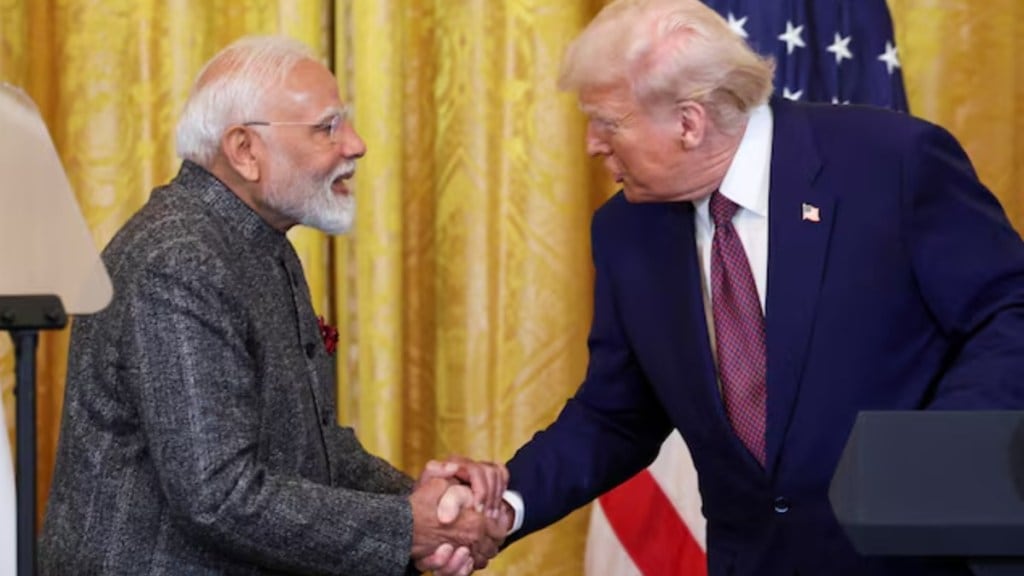The much awaited Trump tariff has been unveiled and US President Donald Trump has slapped a 26% reciprocal tariff on India. While India is set to analyse the tariff and issue a statement, the 10% baseline tariff is applicable on all imports from April 5 and higher duties on certain other countries including 34% on China and 46% on Vietnam. The reciprocal tariff will be effective from April 9.
Gaura SenGupta, chief economist at IDFC First Bank explained, “On a US imports weighted basis, the overall tariffs imposed are 28%. The tariffs are much higher than what would have been implied by reciprocal tariff differentials. It’s seems that non-tariff barriers have also been included in the calculation. For India the tariff imposed is 27%, which is higher than tariffs imposed by India as per WTO data of 11.4%. “
Garima Kapoor, Economist and Executive Vice President, Elara Capital added that, “Based on our provisional calculations of the Reciprocal tariffs, we expect a max 40bps drag on FY26E GDP. To be noted, this excludes items under Section 232 that are already tariffed / would be tariffed. For now, we retain our Feb-25 call of 40-70bps overall impact of Reciprocal Tariffs on India’s FY26E nominal GDP growth in case of high to severe impact.”
Four key impact of Trump Tariff on India
While the overall 26% tariff is significantly high for India, is the Trump tariff all bad news for India? Here is a look at key highlights of Trump tariff and how it impacts India.
Pharma sector excluded from Tariff burden
The Pharma sector has been excluded from tariffs announced by Trump administration along with semiconductors, critical minerals. According to international brokerage firm Citi, “though there is no clarity yet on whether this is a short-term or medium-term arrangement, would view it as positive. This is in line with our stance.”
According to CLSA, “Pharma exempted is positive considering street expectation of up to a 10% tariff on Indian pharma exports to US. Key stocks with higher revenue mix from the US are Aurobindo (48%), Zydus (47%) and Dr Reddys (46%).”
Big tariff drag on China: What it means for India
China is facing 50-55% tariffs ( 20% earlier announced plus 34%) and that can be a key risk for India according to Garima Kapoor as this could “flare up RMB devaluation discussions, and it looking for renewed partnerships in Asia raises dumping and deflationary risk across the continent. The drag can amplify if supply chain re-orientation and value addition costs move higher and the duration of these tariffs are longer. As a mitigating strategy, expect ramp up in expansionary bias in domestic policy mix in the upcoming quarters especially on monetary policy front. Focus now turns on the potential negotiations between affected nations and US, and also inter-continental countries which can magnify existing geopolitical fragmentation. We continue to expect a first leg of deal to be singed between India and US before September as negotiations are ongoing.”
Can India get a competitive edge
According to Motilal Oswal, “higher reciprocal tariffs on China, Vietnam, Bangladesh, and Indonesia may give India a competitive edge.” Indian exporters are expected to eke out potential gains compared to the Asian peers.
Saurabh Agarwal, Tax partner, EY India explained, “While 18% of India’s total exports are destined for the US, anticipated supply chain shifts are expected to open new export opportunities. Although short-term export fluctuations may occur, the mid-to-long term outlook suggests possible export growth for India (contingent on final international trade negotiations with the US). To fully leverage this potential, the Indian government should expand existing Production Linked Incentive (PLI) schemes in these sectors to cover a wider range of products and extend their duration by two years, thereby bolstering domestic industries’ investment and global competitiveness.”
All eyes are on the Govt statement later today and the impact of the ongoing negotiations. The White house statement clearly pointed out that, “tariffs would remain in effect until Trump determined that the threat posed by the trade deficit and underlying non-reciprocal treatment is satisfied, resolved, or mitigated.”
India to suffer impact of global growth slowdown
The White House said in a statement on tariff elaborated that “India imposed ‘uniquely burdensome’ non-tariff barriers, the removal of which will increase US. exports by at least $5.3 billion annually.”
According to Sengupta, “The broad based nature of the tariffs and potential retaliation by other countries is likely to have a negative impact on global growth. India’s exports to the US is only 4% of GDP so direct impact is limited. Impact will be more from overall global growth slowdown and heightened global financial volatility.”
However, one must keep an eye on how the tariff impacts the specific sectors. The exact contours of the differential tariff needs to be clarified. It is likely to be win some lose some for India with a key focus on what the heavy tariff on other Asian peers can mean for Indian businesses.

